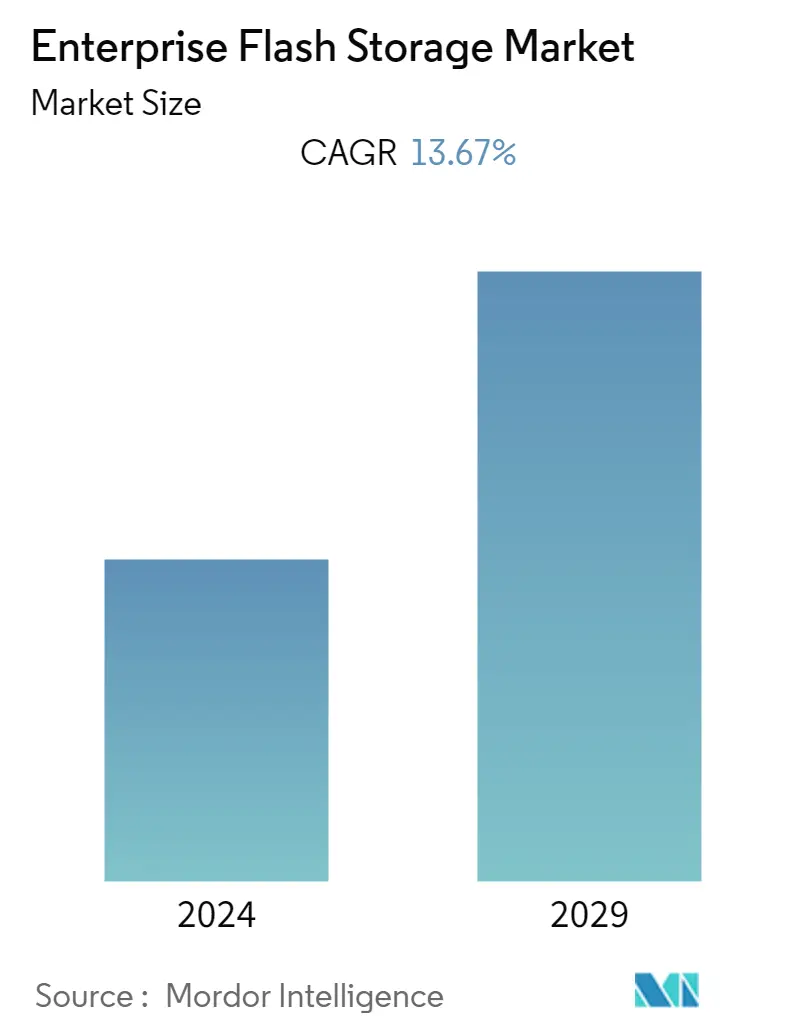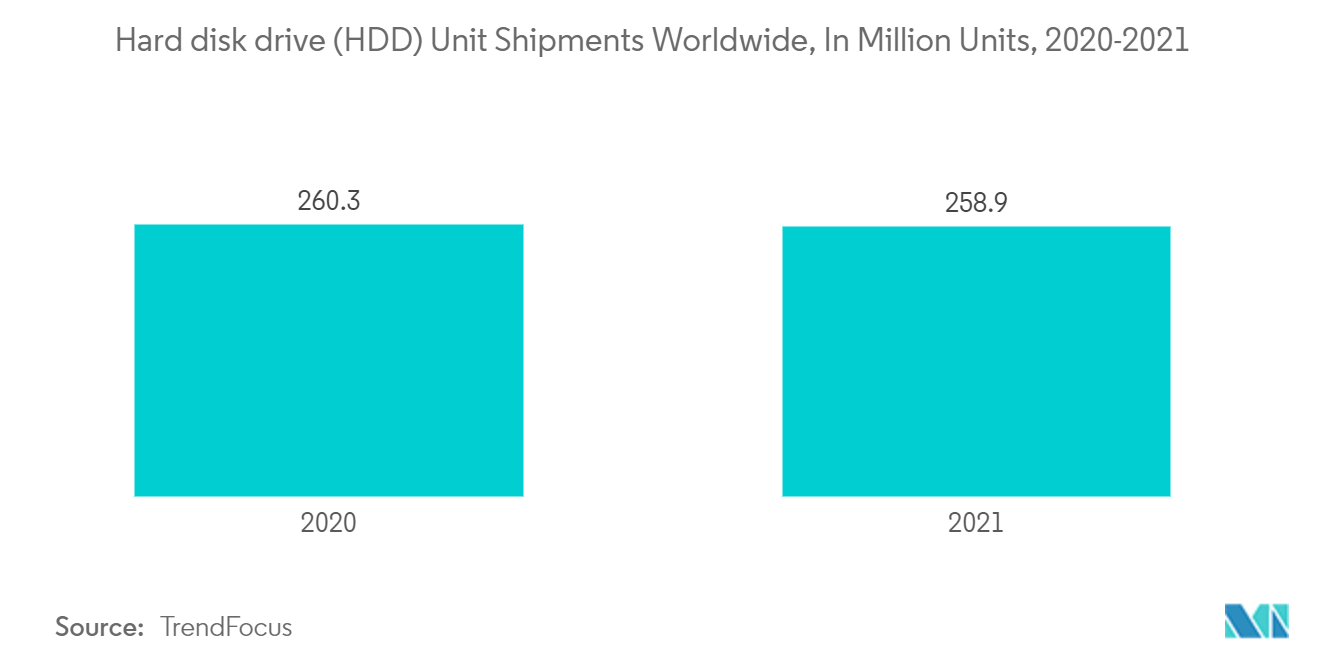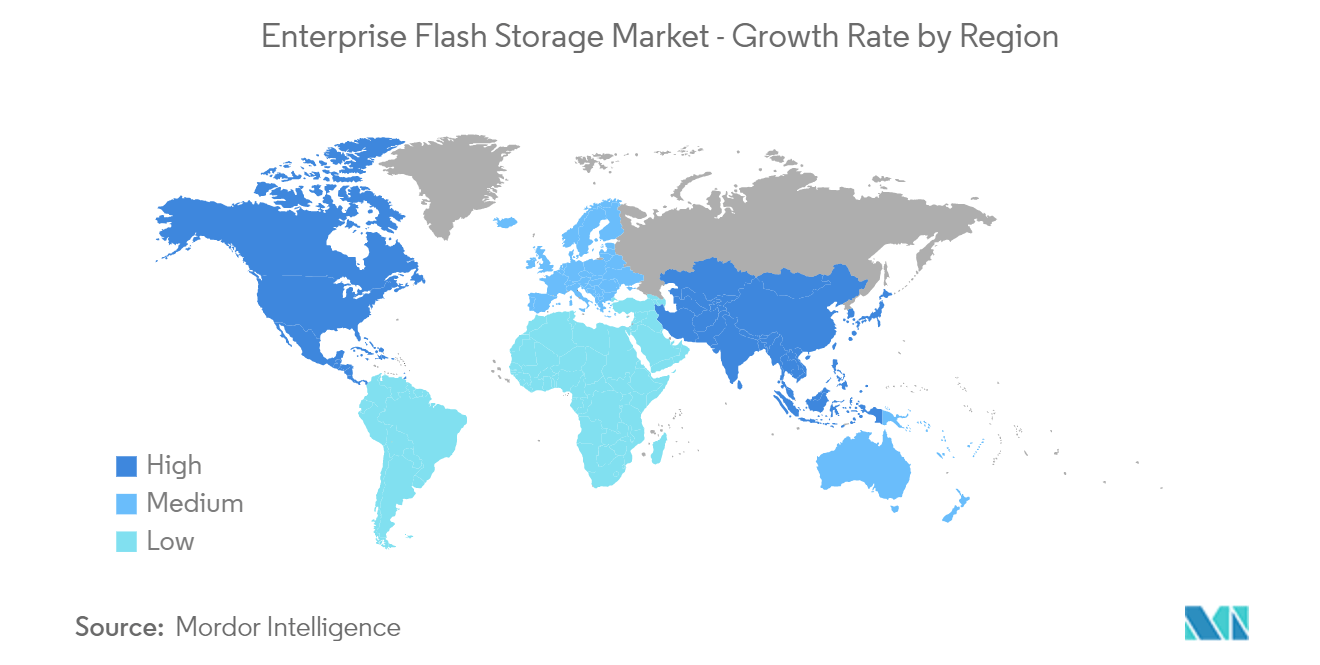Enterprise Flash Storage Market Size

| Study Period | 2021 - 2029 |
| Base Year For Estimation | 2023 |
| CAGR | 13.67 % |
| Fastest Growing Market | Asia-Pacific |
| Largest Market | North America |
| Market Concentration | Low |
Major Players
*Disclaimer: Major Players sorted in no particular order |
Enterprise Flash Storage Market Analysis
The Enterprise Flash Storage Market is expected to register a CAGR of 13.67% over the forecast period. A large amount of raw data is generated daily, leading to a data storage crisis for companies. The enterprise storage market is the most active, as storage users have been subjected to repeated hype for decades. Consumers shifted from hard disk drives (HDDs) to solid-state drives (SSDs); they are further expected to move towards the upcoming all-flash arrays (AFAs). Enterprises are attempting to devise a strategy for strategically deploying approaches to maximize return on investment.
- The growing adoption of cloud technology, coupled with growth in the amount of data generated by enterprises, is expected to drive the market. The adoption of flash storage is in demand in enterprise data centres globally. There are advantages in terms of power consumption, performance, scalability, and ease of management that boost the adoption rate.
- Non-Volatile Memory Express (NVMe) and other changes have helped the market for enterprise flash storage grow. Mission-critical applications, including real-time analytics and demanding database systems, can be performed easily with flash storage systems. So can virtual servers, financial systems, virtual desktop platforms, and data analytics applications that gather vast amounts of data.
- Aided by the demand for digitization, it is expected to contribute value to different end-user industries, such as BFSI and IT services, and raise the global need for mega data centers. On the other hand, new enterprise storage investments were made because of the need for public cloud resources and a global enterprise infrastructure update.
- Flash is becoming the game changer in delivering hybrid-cloud environments to support on-premise, the edge, and public cloud infrastructure consumption. Another benefit of flash storage is its flexibility and ability to be deployed into more dynamic environments than traditional removable storage, such as a cache or persistent buffer for IoT devices, cameras, and sensors. Flash storage is enabling IT transformation in a variety of organizations of all sizes.
- The global pandemic, COVID-19, and the surge in data consumption due to the lockdown have led to a shortage and higher prices for memory and storage products to counter the demand for data center operations. Although limited production has resumed, the current supply is quickly being stockpiled by large technology companies. Drive vendors expect that the high price of flash drives will continue into next year because of low stock, long wait times, and problems with production.
Enterprise Flash Storage Market Trends
This section covers the major market trends shaping the Enterprise Flash Storage Market according to our research experts:
IT & Telecom Sector to Hold Significant Market Share
- The IT and telecom industry is the largest market value segment in the flash storage market and is expected to be the highest earner during the forecast period.The demand for flash devices will remain stable in the client and enterprise markets for the next few years, owing to technological advancements. These factors will likely increase the availability of better technology at lower prices.
- The rapid growth in the usage of storage devices is justified by the companies' increased amount of data generated and processed. SSDs were mostly used in consumer devices or to give a server or storage array a little boost in performance.
- HDDs are still not exhausted in the market and still hold a considerable share. The IT industry relied immensely on hard drives to store data before the evolution of the cloud and online drives. The growth rate of flash storage devices is significantly increasing in the market. This transformation is slowly underway but is considered an effective solution to store data physically, which enables data security more than any other online database used explicitly for storage.
- With the development of high-density flash technologies, all-flash storage solutions offer faster performance and higher capacity in a fraction of the data center footprint. As the amount of data in the IT field continues to grow, businesses can save a lot of money over time by making management easier and using less space, power, and cooling.
- Data is becoming an essential differentiator for businesses of all sizes, and they are increasingly leveraging it to accelerate competitiveness and revenue through better and more informed decision-making. As a result, more and more companies, big and small alike, are using artificial intelligence and machine learning to enhance their competence across several functions.
- Artificial intelligence and machine learning applications rely on large volumes of data to function. These applications need a large amount of data for effectiveness and accuracy. Moreover, the data must be processed in real-time and stored for later use in ML and deep learning (DL). Storage can become the bottleneck for the practical usage of artificial intelligence and machine learning applications. This can be mitigated using the right storage: a mix of flash and hard drives-flash-based for ingesting and real-time processing, and a hard disk for ample data storage and scalability.
- Enterprises are also using flash for backup of high-performance application requirements. Flash storage (especially NVMe flash) has become famous for fast restores. In the wake of a cyberattack, power outage, or any other disruption, it is crucial to be back online quickly, and flash storage can become indispensable in such use cases. Enterprises use a mix of flash and HDD for hot and cold storage requirements, respectively.
- Additionally, with the advent of support for 4K/8K video, VR/AR applications, and enterprise services such as smart manufacturing, remote inspection, and intelligent security protection leveraging technologies such as 5G, AI is transforming the traditional support tools within the IT and telecom sectors into service innovation platforms where data storage and processing volumes are expected to grow from T-bit level to P-bit level, further leveraging the growth of the market.

Asia-Pacific to Witness Significant Growth
- The global boom in IT and computer technology has triggered the need for the transfer and Storage of vast amounts of data, subsequently pushing up the demand in the region. Owing to a growing number of enterprises In India and international storage vendors entering the market, Asia-Pacific is expected to witness the highest adoption rate.
- Flash storage is enabling IT industries' transformation for organizations of all sizes. All-flash Storage offers a variety of benefits, from lowering latency and increasing IOPS per drive to consolidating workloads, shrinking hardware footprints, minimizing power consumption, and reducing the cost of management. The region is seeking cloud adoption to leverage the increasing need for business innovation and agility and the ability to scale in the competitive market, followed by government initiatives toward digital India.
- Currently, India is immediately after China as the fastest-growing cloud services market across the Asia Pacific. Digital disruption is expected to drive flash storage in India, especially in taxi industries, government, hospitals, public education, and manufacturing. Furthermore, IoT, where every sensor produces some amount of data that needs to be stored somewhere to do analytics, is also expected to drive flash storage adoption in the country as IoT penetration increases.
- Pure Storage, an IT pioneer that delivers the world's most advanced data storage technology and services, inaugurated its new India Research and Development Center in Bangalore in June 2022. The center's prime focus is on innovations transforming Storage and data management. According to the company, these are the areas where India can play a global role.
- The global digital transformation is fueling data growth, specifically unstructured data such as video, picture, and audio files. Pure Storage has a broad portfolio of data management solutions, including FlashArray, FlashBlade, FlashStack, AIRI, Pure as-a-Service, Portworx, Pure1, Evergreen, and Pure Cloud Block Store and Purity. The India research and development center will contribute to the continued innovation in most of these product lines.

Enterprise Flash Storage Industry Overview
The Enterprise Flash Storage Market is very competitive by nature. The market is highly concentrated due to the presence of various small and large players. All the major players account for a large share of the market and are focusing on expanding their consumer base across the world. Some of the significant players in the market are Pure Storage, Inc.; StorCentric, Inc.; Oracle Corporation; Dell, Inc.; Hewlett-Packard Enterprise Development LP; and many more. The companies are increasing their market share by forming multiple partnerships and investing in introducing new products, thus earning a competitive edge during the forecast period.
In May 2022, NetApp collaborated with NVIDIA on artificial intelligence infrastructure solutions for many years. NetApp announced the certification of NetApp all-flash NVMe storage and the BeeGFS parallel file system with the NVIDIA DGX SuperPOD. The NVIDIA DGX SuperPOD is an AI data center infrastructure platform delivered as a turnkey solution for IT to support the most complex AI workloads facing today's enterprises. DGX SuperPOD simplifies deployment and management while providing virtually limitless scalability for performance and capacity.
In March 2022, Western Digital Corporation and Samsung collaborated on next-generation fast storage technologies. The collaboration aims to standardize and drive broad adoption of next-generation data placement, processing, and fabric (D2PF) storage technologies. In other words, the two brands are collaborating to work on next-gen SSD technology and an ecosystem for zoned storage solutions. Samsung and Western Digital have already indulged in developing high-speed storage solutions, and the companies are focusing on enterprise, cloud applications, and the Zoned Storage ecosystem. Zoned storage is a category of storage devices that allows hosts and storage devices to cooperate to deliver high-capacity storage with low latencies.
Enterprise Flash Storage Market Leaders
-
Hewlett Packard Enterprise Development LP
-
NetApp
-
Dell Inc.
-
Pure Storage, Inc.
-
Western Digital Corporation
*Disclaimer: Major Players sorted in no particular order

Enterprise Flash Storage Market News
- June 2022: Pure Storage Inc. announced the introduction of Evergreen/Flex. This new fleet-level Evergreen architecture extends the power of Pure's Evergreen technology to the entire Pure portfolio. Evergreen//One offers organizations an accurate consumption-based service model for storage, delivering flexibility, transparency, and simplicity along with proactive monitoring and non-disruptive upgrades while satisfying performance and usage SLAs. With Evergreen//One, Pure takes on the responsibility of delivering storage where it is required, offering on-demand storage service with the flexibility of on-premises deployment.
- April 2022: To address the requirements of modern applications, StorCentric, provider of a comprehensive portfolio of secure data management solutions, announced the general availability (GA) launch of the Nexsan Unity NV10000, an enterprise-class NVMe All-Flash platform engineered from the ground up with superior performance. The new NVMe data storage solution also has uniquely built-in features and functionality critical for ensuring data security, regulatory compliance, and fast recovery from ransomware attacks.
Enterprise Flash Storage Market Report - Table of Contents
1. INTRODUCTION
- 1.1 Study Assumptions and Market Definition
- 1.2 Scope of the Study
2. RESEARCH METHODOLOGY
3. EXECUTIVE SUMMARY
4. MARKET INSIGHTS
- 4.1 Market Overview
-
4.2 Industry Attractiveness - Porter's Five Forces Analysis
- 4.2.1 Bargaining Power of Suppliers
- 4.2.2 Bargaining Power of Consumers
- 4.2.3 Threat of New Entrants
- 4.2.4 Threat of Substitutes
- 4.2.5 Intensity of Competitive Rivalry
- 4.3 Impact of COVID-19 on the Enterprise Flash Storage Market
5. MARKET DYNAMICS
-
5.1 Market Drivers
- 5.1.1 Evolution of Hybrid Flash Arrays and Increased Sales of All Flash Arrays
- 5.1.2 Increased Storage Capacity and Price Reduction Leading to Preference Over HDDs
-
5.2 Market Challenges
- 5.2.1 Compatibility and Optimum Storage Performance Issues
6. MARKET SEGMENTATION
-
6.1 By Type
- 6.1.1 All-Flash Array
- 6.1.2 Hybrid Flash Array
-
6.2 By End-user Industry
- 6.2.1 IT & Telecom
- 6.2.2 Automotive
- 6.2.3 BFSI
- 6.2.4 Healthcare
- 6.2.5 Defense
- 6.2.6 Other End-user Industries
-
6.3 By Geography
- 6.3.1 North America
- 6.3.2 Europe
- 6.3.3 Asia Pacific
- 6.3.4 Latin America
- 6.3.5 Middle East and Africa
7. COMPETITIVE LANDSCAPE
-
7.1 Company Profiles
- 7.1.1 Pure Storage, Inc.
- 7.1.2 StorCentric, Inc.
- 7.1.3 Oracle Corporation
- 7.1.4 Dell Inc.
- 7.1.5 Hewlett Packard Enterprise Development LP
- 7.1.6 Nimbus Data
- 7.1.7 Western Digital Corporation
- 7.1.8 IBM Corporation
- 7.1.9 Huawei Technologies Co., Ltd.
- 7.1.10 Hitachi Vantara LLC
- 7.1.11 NetApp
- *List Not Exhaustive
8. INVESTMENT ANALYSIS
9. FUTURE OF THE MARKET
** Subject To AvailablityEnterprise Flash Storage Industry Segmentation
Flash is a memory type that works quickly and efficiently compared to conventional HDDs without continuous power. Solid-state drives are currently being implemented with NAND-based flash memory to allow the memory to retain data without power. Flash storage can boot in a matter of seconds and handle large workloads more efficiently, making it ideal for complex data sets and operations. Businesses require fast processing for their applications and quick access to stored data. This makes flash memory storage an ideal application for their use.
The Enterprise Flash Storage Market is segmented by Type (All-Flash Array, Hybrid Flash Array), by End-user Industry (IT & Telecom, BFSI, Healthcare), and by Geography (North America, Europe, Asia Pacific, Latin America, MEA). The market sizes and forecasts are provided in terms of value (USD million) for all the above segments.
| By Type | All-Flash Array |
| Hybrid Flash Array | |
| By End-user Industry | IT & Telecom |
| Automotive | |
| BFSI | |
| Healthcare | |
| Defense | |
| Other End-user Industries | |
| By Geography | North America |
| Europe | |
| Asia Pacific | |
| Latin America | |
| Middle East and Africa |
Enterprise Flash Storage Market Research FAQs
What is the current Enterprise Flash Storage Market size?
The Enterprise Flash Storage Market is projected to register a CAGR of 13.67% during the forecast period (2024-2029)
Who are the key players in Enterprise Flash Storage Market?
Hewlett Packard Enterprise Development LP, NetApp, Dell Inc., Pure Storage, Inc. and Western Digital Corporation are the major companies operating in the Enterprise Flash Storage Market.
Which is the fastest growing region in Enterprise Flash Storage Market?
Asia-Pacific is estimated to grow at the highest CAGR over the forecast period (2024-2029).
Which region has the biggest share in Enterprise Flash Storage Market?
In 2024, the North America accounts for the largest market share in Enterprise Flash Storage Market.
What years does this Enterprise Flash Storage Market cover?
The report covers the Enterprise Flash Storage Market historical market size for years: 2021, 2022 and 2023. The report also forecasts the Enterprise Flash Storage Market size for years: 2024, 2025, 2026, 2027, 2028 and 2029.
Enterprise Flash Storage Industry Report
Statistics for the 2024 Enterprise Flash Storage market share, size and revenue growth rate, created by Mordor Intelligence™ Industry Reports. Enterprise Flash Storage analysis includes a market forecast outlook to 2029 and historical overview. Get a sample of this industry analysis as a free report PDF download.



